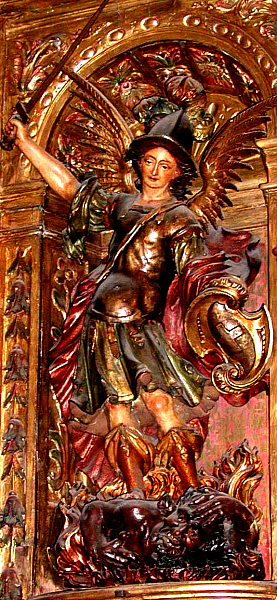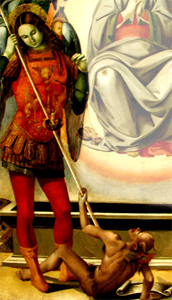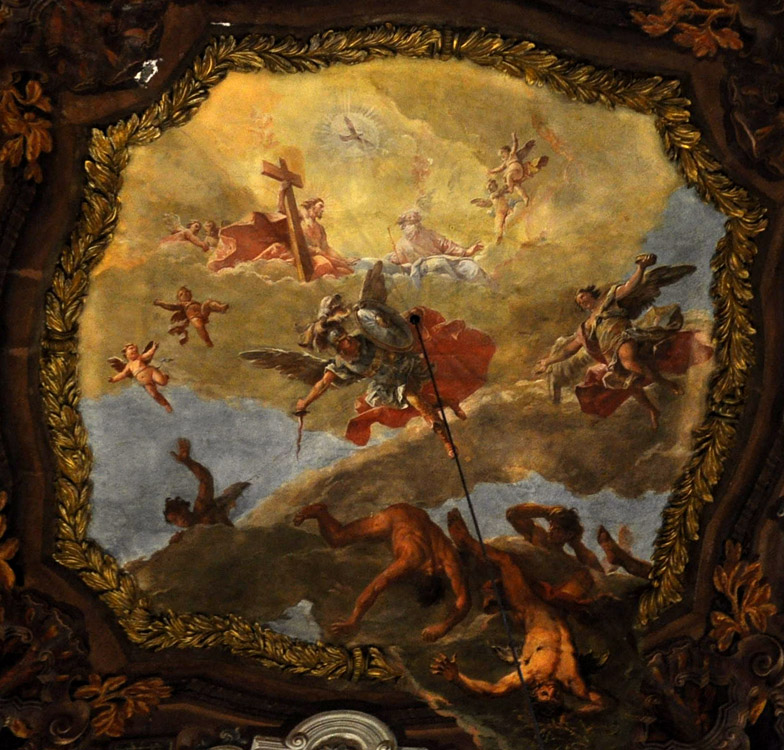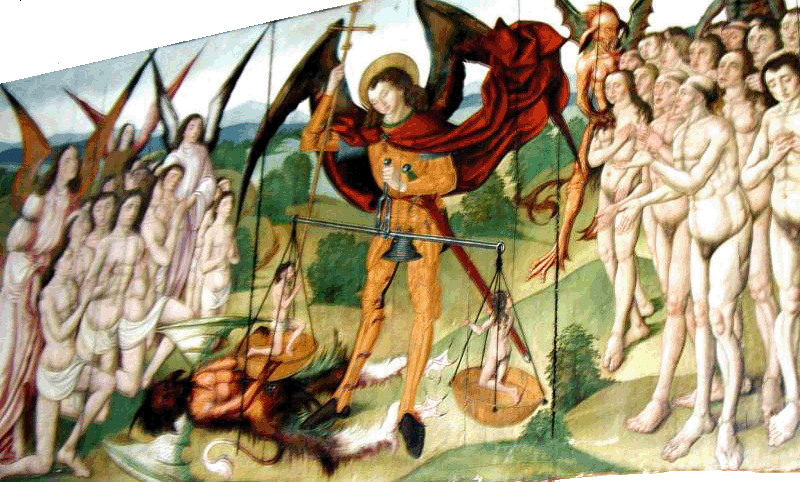Scripture provides no direct account of the Fall of Satan, but two texts were interpreted as referencing it. The first is in Isaiah's oracle against the King of Babylon (14:12-14). In the Vulgate the king is called Lucifer:
How art thou fallen from heaven, O Lucifer, who didst rise in the morning? How art thou fallen to the earth, that didst wound the nations? And thou saidst in thy heart: I will ascend into heaven, I will exalt my throne above the stars of God, I will sit in the mountain of the covenant, in the sides of the north. I will ascend above the height of the clouds, I will be like the most High. But yet thou shalt be brought down to hell, into the depth of the pit.Christians took this text allegorically to refer to the fall of Lucifer/Satan. Christ himself had said, "I saw Satan like lightning falling from Heaven" (Luke 10:18), and later he related this primal victory to the one he would gain on the Cross: "Now is the judgment of the world: now shall the prince of this world be cast out" (John 12:32).
That Satan's fall from Heaven was effected by a host of angels led by Michael was taken to be the meaning of Revelation 12:7-9):
And there was a great battle in heaven, Michael and his angels fought with the dragon, and the dragon fought and his angels: And they prevailed not, neither was their place found any more in heaven. And that great dragon was cast out, that old serpent, who is called the devil and Satan, who seduceth the whole world; and he was cast unto the earth, and his angels were thrown down with him.Countless texts have retold the story of this primal victory over Satan. Gregory the Great refers to it in his 6th-century Homilies on the Gospels (XXXIV, ¶9), the Golden Legend includes it in the section on Michael, and it provides the first scene in the English mystery plays at Wakefield, Chester, and N-town.2 Perhaps the best known account occupies the whole of Book VI in Milton's Paradise Lost.
The scripts of the plays do not mention Michael by name, and in Milton he fails to dislodge Lucifer and the Son must come in for the final victory. But in visual art it is always Michael who prevails, as in this spectacular panel from a Spanish altarpiece.
ST. MICHAEL AND THE LAST JUDGMENT
St. Michael is also commonly included in Last Judgment scenes, as in the picture at the top of this page. Daniel 12:1 says that at the end of the world Michael will "rise up, the great prince, who standeth for the children of thy people…and at that time shall thy people be saved."3 But in images of the Last Judgment his role is not so much the defense of the faithful as the weighing of souls, the so-called Psychostasy for which the artists provide a balance-scale, usually with a soul sitting on one of the pans and a devil pulling down on that pan (See this additional example.) Molanus (347) interprets the scale as a reminder that God will judge us in aequitatem, and he cites a number of verses and commentaries where the scale metaphor expresses God's equitable judgment.As for the devil tugging on the pan, Molanus says he is the "lying accuser" who will seek to have the most severe penalties exacted for any wrongs we may have committed. In a related image type the lying accuser stands on the left claiming his prey in the scales while Christ or Mary on the right intercedes for the just (example).
In Dante's Inferno (IX, 76-105) Michael is a stern figure denouncing those newly arrived in Hell. But in the liturgy he is "the standard-bearer" who will guide the souls of the faithful departed "into the holy light, which thou didst promise of old to Abraham and his seed."4 In a painting of Paradise at California's Mission San Miguel, Michael stands in the center, pictured larger even than the Trinity, with seated saints to his left and right and faithful souls approaching from below and looking to him (Neuerburg, 3).
Many portraits of St. Michael, such as the second one at right, will include both the scales and the vanquished Satan, suggesting that Michael's is a victory for justice. Images of this type will picture Satan in human form, not as a dragon. Like the picture at the top of this page, this example goes further by making the vanquished Satan the same demon who pulls down on the pan.
THE SHRINE ON MOUNT GARGANO
A shrine to St. Michael on Mount Gargano, in southern Italy, has been a pilgrimage site since at least the 6th century. In the late 7th or early 8th century a book appeared that placed the history of the shrine in earlier times when the local area was Christian but others were not. In the book, St. Michael builds a church on the mountain and later fends off an invasion by pagans from Naples (Everett, 73-78). For more details and a fresco illustrating the story, follow this link.PORTRAITS
In early images Michael and Gabriel hold sceptres and flank the throne of the Virgin dressed as Byzantine courtiers (see this example and Weitzmann, Icon, pages 45, 47, and 51).Later images in the West are mostly narrative, but one pax In medieval times, a metal tablet with an image of Christ or a saint that was kissed by the celebrant and others during the Mass in the treasury of Zadar Cathedral has SS. Agatha and Michael flanking the Madonna and Child (Petricioli, 107). In western images Michael is identified by military dress and either or both of two attributes: a spear or sword referencing the fall of Satan, and scales for his role in the Last Judgment.
IN POPULAR CULTURE
St. Michael's victory over Satan is a powerful symbol in popular culture. On Brooklyn's Atlantic Avenue, one lawyer placed a statuette group featuring the saint's victory in his storefront window, as if suggesting how aggressively he would defend his clients. In Salamanca, Spain, we spotted a weathervane with the same subject. And in the 2009 film Brooklyn's Finest the spiritually troubled character played by Ethan Hawke has on his back a large tattoo with St. Michael vanquishing Satan and the first words of the "Prayer to St. Michael." In 2018 Pope Francis suggested that Catholic churches could respond to the scandals and divisions roiling the Church by saying that prayer after each Mass, and many American parishes have chosen to do so.5
Prepared in 2014 by Richard Stracke, Emeritus Professor of English, Augusta University.
HOME PAGE
The Weighing of Souls: Hispano-Flemish painter, early 16th century (see the description page)
OTHER IMAGES

A statue in the cathedral in Barcelona – See the description page

Detail from Signorella's Assumption of the Virgin – See the description page

St. Michael drives Satan and his angels out of Heaven in this dramatic cross-vault fresco in Venice. See the description page.
MORE IMAGES
- Late Gothic: A statue in Galicia combining the scales with the victory over Satan.
- Late Gothic: An unusual fresco of the Psychostasy featuring the intercession of the Madonna and Child.
- 1390s: St. Michael with Satan at his feet is among the saints on the left wing of Cenni di Francesco's Coronation of the Virgin Altarpiece.
- 15th century: A portrait of St. Michael in a Spanish altarpiece of the Pietà.
- A 15th-century fresco in Croatia combining Michael's roles in the victory over Satan and in the psychostasy.
- 1405: A Spanish portrait with St. Amator.
- 1442: Bernat Martorell's Saints Michael, Eulalia, and Catherine of Alexandria.
- 1490: A statue in Regensburg with attributes but no wings.
- Late 15th century: Fresco with St. Michael and the Virgin Mary.
- First half of the 16th century: Adriaen Isenbrant's Crucifixion with Saints ironically juxtaposes St. Michaels defeat of Satan with a scene of modern warfare.
- 16th or 17th century: A santo of St. Michael in Cuilapan, Mexico and another in Huitzo.
- 17th century: Giovanni di San Giovanni's Three Holy Archangels (Gabriel, Michael, Raphael).
- 1726: Giuseppe Torretti's The Archangel Michael is in the "Gesuiti" church in Venice, one of four monumental statues of the archangels.
- 1753: In the margin of a Mexican nun's badge.
- 1760: C. A. Mayr's vault fresco in Innichen, Italy, pictures the victory over Satan along with prelapsarian garden and the repentance of mankind.
- 1782: St. Michael drives Satan and his angels out of Heaven in this elaborate altarpiece in Vienna.
- 19th century: A santo at Mission San Juan Capistrano, California.
- 2009: A poster with the traditional iconography used in a religious festival in Santa Fe, New Mexico.
- Undated: A high relief in the usual iconography but without Satan and with an "IHS" on the banner.
- Undated: A tympanum in Zadar, Croatia: Michael vanquishing Satan.
- Undated: A statue in Switzerland with both the fiery sword and the scales.
NAMES
- The name "Michael" means "Who is like God?"
- Molanus (348-49) says he is called "archangel" because of his leadership in the two great battles and is not actually a member of the order of Archangels.
DATES
- September 29 is the "Feast of St. Michael and All Angels."
ALSO SEE
MEDIEVAL TEXTS
- The Book Concerning the Apparition of St Michael on Mount Gargano. In Everett, 79-83.
- Golden Legend #145: html or pdf.
- South English Legendary, 299-322.
- Acta Sanctorum, September vol. 8, 5-123.
- Alcuin's 8th-century Sequentia de Sancto Michaele (Liturgical hymn for the Mass on the Feast of St. Michael and All Angels, in Latin).
- Liber de Apparitione Sancti Michaelis in Monte Gargano, in MHG: Scriptores Rerum Langobardicarum et Italicarum, I, 540-46.
NOTES
1 Roman Martyrology for September 29. The church in Mount Gargano, in southern Italy, became a pilgrimage destination during the Middle Ages. See Acta Sanctorum, September vol. 8, 54-74.
2 Wakefield's The Creation and Fall of the Angels: Bevington, 258-66. Chester's The Fall of Lucifer: Deimling I, 9-20. The N-Town Creation of Heaven and Fall of Lucifer is in Sugano.
3 Butler (III, 677-79) traces the history of Michael's reputation as, first, a protector of Israel, and subsequently in Christian thought, as a "psychopomp" or guide for souls in the Last Judgment.
4 From the offertory of the Tridentine Mass for the Dead: "O Lord Jesus Christ, King of glory, deliver the souls of all the faithful departed from the pains of Hell and from the deep pit: deliver them from the mouth of the lion, that Hell may not swallow them up, and they may not fall into darkness; but may the holy standard-bearer Michael introduce them to the holy light: Which Thou didst promise of old to Abraham and to his posterity." Molanus (347) follows the same phrasing of that prayer in his comments on Michael's scale: Debeamus deposuisse omne…peccatum, ut signifer sanctus Michael repraesentet nos in lucem sanctam, quae olim Abrahae, & semini eius promissa est, "We should let go of…every sin, so that the holy standard-bearer Michael may introduce us into the holy light that was promised of old to Abraham and his seed."
5 Feuerherd, ""St. Michael the Archangel is back."
